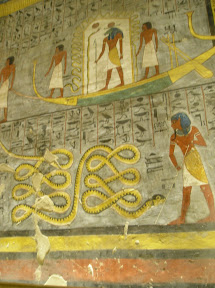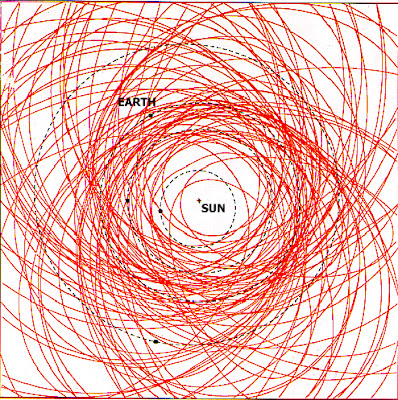Everybody Panic, possibly!
 Standing on the dance floor surrounded by the din of the Wednesday night bar crowd and staring blankly into spaces unfamiliar and faces unreachable, I noticed that Late Night with Conan O'Brien was on. His guest that evening was Neil de Grasse Tyson. The latest in a string of physicists to explain all things cosmic, his apparent street credentials garnered him an audience with the august Mr. O'Brien. Mr. Tyson, one of Time Magazine's 100 most influential people. He was discussing among other things a relatively significantly sized asteroid that has a pretty good chance (pretty good as far as the mind-boggling expanses of deep space allow) of striking the Earth. Originally calculations had the 1000ft diameter traveler striking in 2029, further refinements now suggest that the close fly-by to Earth (so close that it should make a bit of show as it streaks by), specifically Earth's gravitational pull, will alter the trajectory of Apophis in such a way as to set up a possible collision 7 years later on April 13th, 2036 to be exact. Apophis is a Hellenization of the name of the Egyptian Demon Apep. A water snake (pictured left, taken from a Temple in Luxor) he will be slayed by Ra. This of course nicely predetermines the name of the ship/mission that will be sent up there to destroy the asteroid in case the calculations turn out to not to be in our favor. The movie that results should be great, "Armageddon II: Ra Ascending," Bruce Willis' cryogenically frozen body will be reanimated just in time for the sequel and when he is done he can begin work on "Die Hard 14: Please Just Die." The mythological references aside, Tyson informed Conan that "top people were working on this" (pause for sarcasm). The chances of this rocky formation slamming into our dear planet is somewhere around 1/5000 to 1/45000. These are not necessarily overwhelmingly dire odds, but nevertheless some at NASA are concerned, and have begun to develop response strategies in order to potentially avoid disaster. The other factor in Earth's favor (one of the few things that are her favor these days) is that the size of the asteroid will not cause catastrophic damage to the entire planet; however, scientists predict if it were to strike, significant local or regional damage would occur. With all the asteroids and meteors and other NEOs (Near-Earth Objects) how was this possibly threatening one discovered. The Spaceguard Survey since 1998
Standing on the dance floor surrounded by the din of the Wednesday night bar crowd and staring blankly into spaces unfamiliar and faces unreachable, I noticed that Late Night with Conan O'Brien was on. His guest that evening was Neil de Grasse Tyson. The latest in a string of physicists to explain all things cosmic, his apparent street credentials garnered him an audience with the august Mr. O'Brien. Mr. Tyson, one of Time Magazine's 100 most influential people. He was discussing among other things a relatively significantly sized asteroid that has a pretty good chance (pretty good as far as the mind-boggling expanses of deep space allow) of striking the Earth. Originally calculations had the 1000ft diameter traveler striking in 2029, further refinements now suggest that the close fly-by to Earth (so close that it should make a bit of show as it streaks by), specifically Earth's gravitational pull, will alter the trajectory of Apophis in such a way as to set up a possible collision 7 years later on April 13th, 2036 to be exact. Apophis is a Hellenization of the name of the Egyptian Demon Apep. A water snake (pictured left, taken from a Temple in Luxor) he will be slayed by Ra. This of course nicely predetermines the name of the ship/mission that will be sent up there to destroy the asteroid in case the calculations turn out to not to be in our favor. The movie that results should be great, "Armageddon II: Ra Ascending," Bruce Willis' cryogenically frozen body will be reanimated just in time for the sequel and when he is done he can begin work on "Die Hard 14: Please Just Die." The mythological references aside, Tyson informed Conan that "top people were working on this" (pause for sarcasm). The chances of this rocky formation slamming into our dear planet is somewhere around 1/5000 to 1/45000. These are not necessarily overwhelmingly dire odds, but nevertheless some at NASA are concerned, and have begun to develop response strategies in order to potentially avoid disaster. The other factor in Earth's favor (one of the few things that are her favor these days) is that the size of the asteroid will not cause catastrophic damage to the entire planet; however, scientists predict if it were to strike, significant local or regional damage would occur. With all the asteroids and meteors and other NEOs (Near-Earth Objects) how was this possibly threatening one discovered. The Spaceguard Survey since 1998  has been devoted to discovery, tracking and assessment of these objects. The graph to the right shows the orbits of the terrestrial planets along with the orbits of the 100 nearest-to-Earth objects. The Spaceguard, which took its name from a similarly tasked research body in the Arthur C. Clarke novel, Rendezvous with Rama, has quite a lot to look after with a modest budget of approximately $3.5 million per year. Reading the white-paper on this research body is a bit of a jarring experience, considering the catastrophic consequences that abound in between the lines. For example consider this snappy line from the Spaceguard's documentation:
has been devoted to discovery, tracking and assessment of these objects. The graph to the right shows the orbits of the terrestrial planets along with the orbits of the 100 nearest-to-Earth objects. The Spaceguard, which took its name from a similarly tasked research body in the Arthur C. Clarke novel, Rendezvous with Rama, has quite a lot to look after with a modest budget of approximately $3.5 million per year. Reading the white-paper on this research body is a bit of a jarring experience, considering the catastrophic consequences that abound in between the lines. For example consider this snappy line from the Spaceguard's documentation:
Indeed, during our lifetime, there is a small but non-zero chance (very roughly 1 in 10,000) that the Earth will be struck by an object large enough to destroy food crops on a global scale and possibly end civilization as we know it (Shoemaker and others 1990).
"Small but non-zero chance." Comforting, eh? If one becomes concerned about everything in the universe of which there is a small but non-zero chance of occurring then perhaps one would soon be committed to a mental institution suffering from an extreme case of depression and/or paranoia. Nevertheless, I am bemused by the fact that we are surrounded at all levels: locally, nationally, globally, and cosmically by threats and perceived threats (both true and false) to our existence, and despite our occasional complaints about an unnecessary cultivation of fear in our society prompted by our media and our administrations, we are often ignorantly quiescent to many of the less publicized but nonetheless possibly cataclysmic imperilments that we face on a daily basis. More entertaining is that there are people whose job, on a daily basis, is to analyze and consider these imperilments (I am sure many of whom are inside the Beltway) with all the perfunctory flourish of a mailroom attendant. I imagine water-cooler conversations must have a hint of an additional gravitas or maybe they still talk about how much the Redskins need help. Though the sky is not falling, and the bad men aren't always knocking at our door I wonder how much we'd care if we knew they were. Generally, I feel that it is dangers such as this, though not particularly asteroids crashing into Earth, that really are worth fretting over, and many of the so-called dangers to society that are hyped up in the media or by government officials are the things that are the least doom-spelling. The incurious attitude adopted by so many finds me standing in a bar disappointingly alone in my thoughts, looking intently at the TV screen, wondering if I looked hard enough or stood still enough someone else would notice.

No comments:
Post a Comment